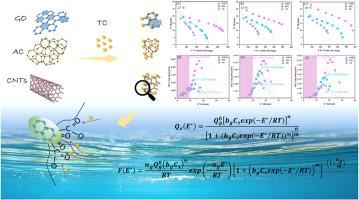Tetracycline adsorption on carbon-based adsorbents: Insights into dimensional and chemical effects
IF 4.7
3区 材料科学
Q1 CHEMISTRY, APPLIED
引用次数: 0
Abstract
This study systematically investigates the adsorption mechanism of tetracycline (TC) by three carbonaceous materials-carbon nanotubes (CNTs), graphene oxide (GO), and activated carbon (AC). Using comprehensive characterization (SEM, BET, FT-IR, and Raman), structural and chemical differences among the materials were revealed. Kinetic analysis shows the adsorption process follows the intraparticle diffusion model and pseudo-second-order kinetics, indicating adsorption capacity is governed by effective site accessibility and TC mass transfer. Thermodynamic studies demonstrate varying average site energies with temperature, with isothermal data described by the Generalized Langmuir model, highlighting adsorption site selectivity in the carbon matrix. Site energy distribution theory reveals high-energy sites exhibit superior efficiency and stronger adsorption affinity for TC. XPS analysis confirms oxygen-containing functional groups dominate TC adsorption mediation. This study proposes the site energy distribution theory, which provides important insights into the structure-activity relationship of carbon adsorbents and facilitates the analysis of complex adsorption processes.

四环素在碳基吸附剂上的吸附:对尺寸和化学效应的见解
本研究系统地研究了碳纳米管(CNTs)、氧化石墨烯(GO)和活性炭(AC)三种碳质材料对四环素(TC)的吸附机理。通过SEM, BET, FT-IR和Raman等综合表征,揭示了材料之间的结构和化学差异。动力学分析表明,吸附过程遵循颗粒内扩散模型和准二级动力学,表明吸附容量受有效位点可达性和TC传质控制。热力学研究表明,利用广义Langmuir模型描述的等温数据,平均位能随温度的变化而变化,突出了碳基体中吸附位的选择性。位点能量分布理论表明,高能位点对TC的吸附效率更高,吸附亲和力更强。XPS分析证实含氧官能团主导TC吸附中介。本研究提出了位能分布理论,为研究碳吸附剂的构效关系提供了重要的见解,并为复杂吸附过程的分析提供了便利。
本文章由计算机程序翻译,如有差异,请以英文原文为准。
求助全文
约1分钟内获得全文
求助全文
来源期刊

Microporous and Mesoporous Materials
化学-材料科学:综合
CiteScore
10.70
自引率
5.80%
发文量
649
审稿时长
26 days
期刊介绍:
Microporous and Mesoporous Materials covers novel and significant aspects of porous solids classified as either microporous (pore size up to 2 nm) or mesoporous (pore size 2 to 50 nm). The porosity should have a specific impact on the material properties or application. Typical examples are zeolites and zeolite-like materials, pillared materials, clathrasils and clathrates, carbon molecular sieves, ordered mesoporous materials, organic/inorganic porous hybrid materials, or porous metal oxides. Both natural and synthetic porous materials are within the scope of the journal.
Topics which are particularly of interest include:
All aspects of natural microporous and mesoporous solids
The synthesis of crystalline or amorphous porous materials
The physico-chemical characterization of microporous and mesoporous solids, especially spectroscopic and microscopic
The modification of microporous and mesoporous solids, for example by ion exchange or solid-state reactions
All topics related to diffusion of mobile species in the pores of microporous and mesoporous materials
Adsorption (and other separation techniques) using microporous or mesoporous adsorbents
Catalysis by microporous and mesoporous materials
Host/guest interactions
Theoretical chemistry and modelling of host/guest interactions
All topics related to the application of microporous and mesoporous materials in industrial catalysis, separation technology, environmental protection, electrochemistry, membranes, sensors, optical devices, etc.
 求助内容:
求助内容: 应助结果提醒方式:
应助结果提醒方式:


